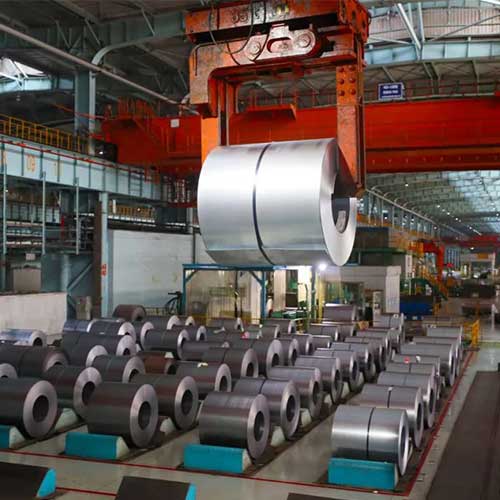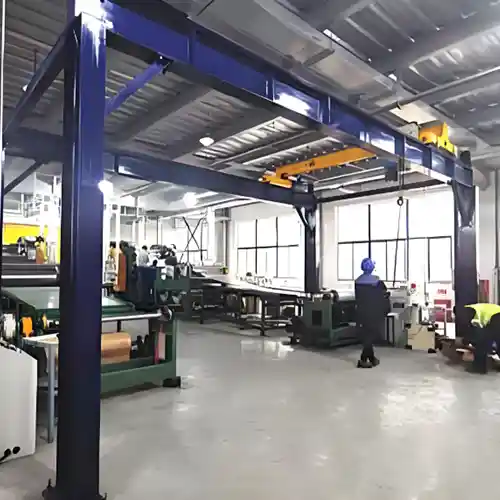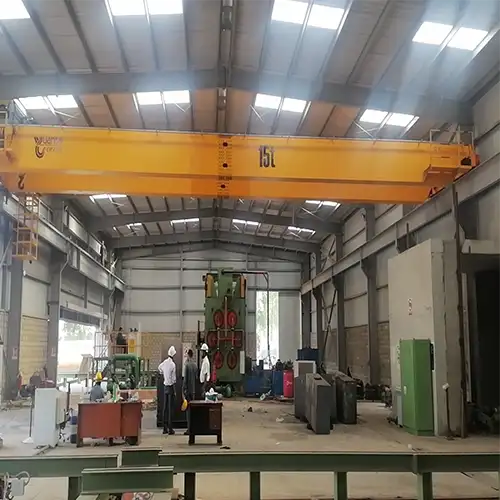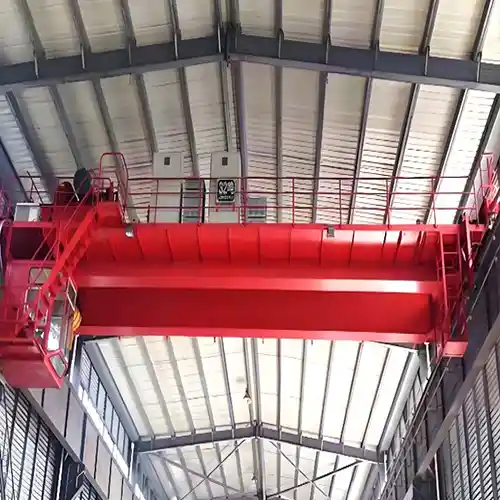Warehouse Cranes: Types,Uses & Costs, Hot Sale 5 Ton, 10 Ton
Warehouse Crane Complete Guide: Types, Features, Benefits, Applications, Costs. Custom warehouse bridge crane, gantry cranes, jib crane for your warehouse.
Category: Indoor Crane
Your Trusted Indoor Warehouse Crane Manufacturer & Supplier
Guide to Warehouse Cranes, Hot Sale Warehouse 5 Ton, 10 Ton
Warehouse Crane Types, Features, Benefits, Applications, Costs, and Top Concerns
A warehouse crane is a type of material handling equipment used in warehouses and distribution centers to efficiently move and manage heavy or bulky loads. These cranes are designed to lift, lower, and transport goods within a warehouse or industrial facility, making it easier to store and retrieve items from high shelves, racks, or storage areas. Warehouse cranes are essential for optimizing storage space and improving the overall efficiency of warehouse operations.
There are several types of warehouse cranes, each designed for specific tasks and environments. Some common types of warehouse cranes include:
Warehouse cranes come in various types, each with its own features, benefits, functions, and applications across different industrial sectors. Here are some typical types of warehouse cranes and their relevant characteristics, advantages, functions, and applications in the mentioned industrial sectors:
Types of Warehouse Cranes
Now, let's dive deeper into the fascinating world of warehouse cranes. Each type of crane offers a unique set of features, benefits, and applications that cater to specific material handling needs.
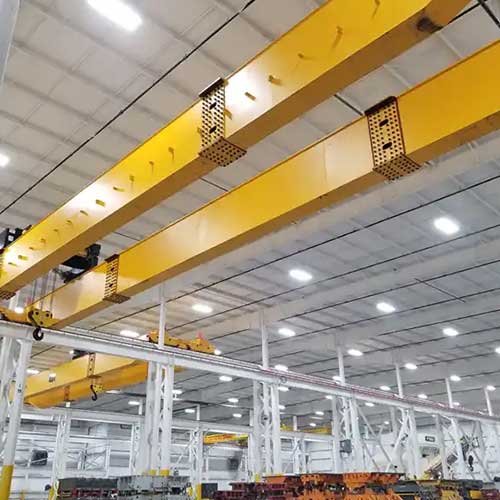
Features and Specifications:
High Lifting Capacity:Overhead bridge cranes are renowned for their ability to handle heavy loads with ease.
- Efficient Use of Vertical Space:They make the most of vertical warehouse space, optimizing storage.
- Wide Coverage:These cranes can traverse a large area, ensuring versatile material handling.
- Durability and Reliability:Overhead bridge cranes are built to withstand rigorous industrial use.
Benefits in Material Handling:
Increased Efficiency:They significantly boost material handling efficiency, reducing downtime.
- Reduced Labor Costs:Fewer manual laborers are needed for heavy lifting tasks.
- Enhanced Safety:Precise load control enhances workplace safety.
- Space Optimization:Vertical storage maximizes warehouse space.
Typical Applications:
Overhead bridge cranes find their stride in various sectors, including manufacturing, logistics, and aerospace. They excel in tasks such as loading and unloading raw materials, positioning heavy machinery, and facilitating storage and retrieval.
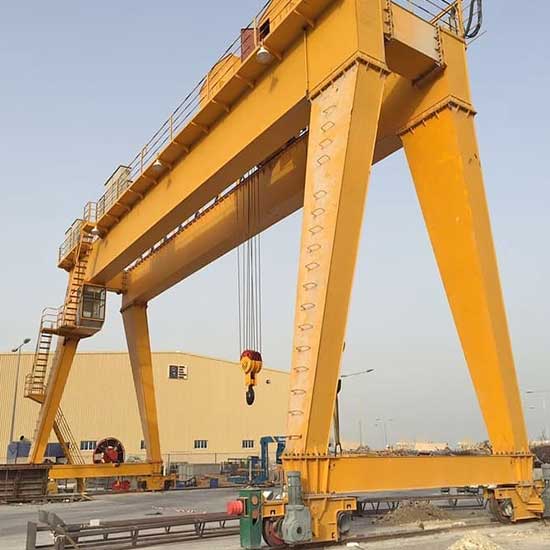
Features and Specifications:
Mobility and Adaptability:Gantry cranes are mobile, making them versatile for material handling.
- High Lifting Capacity:They boast impressive lifting capabilities.
- Precision Control:Gantry cranes offer precision in load control.
- Durability:Designed for rugged environments, they endure industrial wear and tear.
Benefits in Material Handling:
Efficient Material Transport:Gantry cranes are highly efficient in moving heavy loads across the warehouse.
- Flexible Usage:Their adaptability allows for versatile applications.
- Enhanced Workplace Safety:Precision control and safety features minimize accidents.
- Durability for Heavy Loads:They reliably handle heavy materials.
Typical Applications:
Gantry cranes are indispensable in industries like steel and metal fabrication, mining, and construction. They shine in transporting heavy metal sheets, mining equipment, and construction materials.
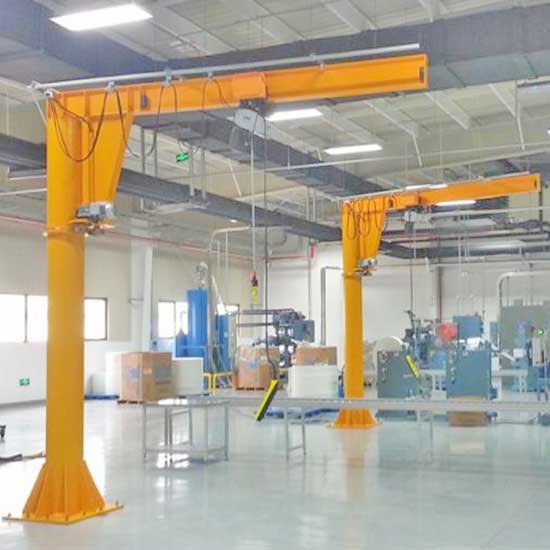
Features and Specifications:
Compact Design:Jib cranes have a compact and space-saving design.
- Precision Control:They offer precise load control for delicate operations.
- Durability:Built for industrial use, they are robust and long-lasting.
- Rotation:Jib cranes can rotate, providing flexibility in positioning materials.
Benefits in Material Handling:
Precise Positioning:Jib cranes excel in positioning materials with accuracy.
- Compact Space Usage:Their design suits facilities with limited space.
- Enhanced Workflow:Jib cranes optimize workflow efficiency.
- Reduced Manual Handling:They reduce the need for manual labor in material handling tasks.
Typical Applications:
Jib cranes are ideal for tasks such as precise positioning of work-in-progress items in manufacturing, handling materials in small workshops, and supporting maintenance operations.
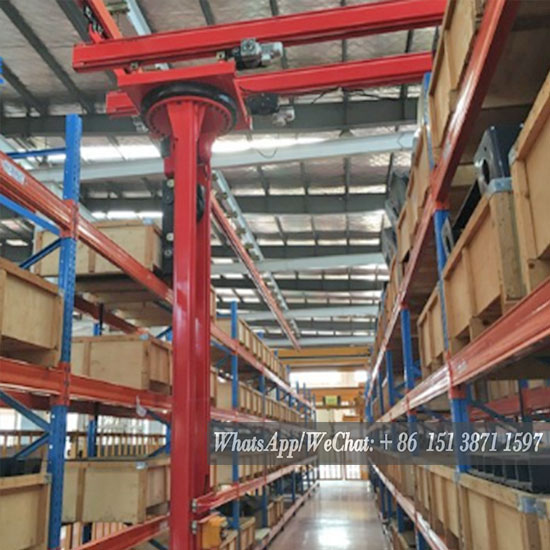
Features and Specifications:
Automation:Stacker cranes are fully automated for rapid storage and retrieval.
- High Storage Density:They offer high-density storage solutions.
- Precision Control:These cranes ensure accurate placement of items.
- Durability:Designed for continuous use in automated storage systems.
Benefits in Material Handling:
Rapid Storage and Retrieval:Stacker cranes enable swift access to stored items.
- Optimized Storage:They make the most of available storage space.
- Efficient Inventory Management:Automated systems enhance inventory control.
- Reduced Labor Dependency:Stacker cranes minimize the need for manual labor.
Typical Applications:
Stacker cranes are revolutionizing the logistics and distribution sector. They are key players in distribution centers, supporting high-speed order picking, and ensuring efficient storage and retrieval.
Customized features and requirements for warehouse cranes
Warehouse cranes used in various industrial sectors may have specific features or requirements tailored to the unique needs of each sector. While the exact features and requirements can vary depending on the application and industry, here are some common features and requirements to consider when selecting a warehouse crane:
- 1. Lifting Capacity:- The crane's lifting capacity should match the weight of the materials or loads it will handle. Industrial sectors dealing with heavy materials may require high-capacity cranes.
- 2. Span and Reach:- The span (distance between runway supports for overhead cranes) and reach (horizontal coverage) of the crane should align with the layout and dimensions of the workspace or storage area.
- 3. Height Clearance:- Consider the vertical space available in the facility to ensure that the crane can lift materials to the required height without obstruction.
- 4. Mobility:- Depending on the industry, mobility may be essential. Gantry cranes and automated guided vehicles (AGVs) offer mobility for various applications, including outdoor use in construction and ports.
- 5. Speed and Precision:- Some industries require fast and precise positioning of materials. Automated systems often excel in this regard, ensuring efficient and accurate material handling.
- 6. Safety Features:- Safety is paramount. Cranes should have safety features such as overload protection, emergency stop buttons, anti-collision systems, and warning signals to protect both equipment and personnel.
- 7. Environmental Considerations:- In some sectors, such as cold storage or hazardous material handling, cranes may need to be specially designed to operate in extreme temperatures, corrosive environments, or potentially explosive atmospheres.
- 8. Automation and Integration:- Industries with high-volume and repetitive tasks may benefit from automation and integration capabilities, such as computerized control systems and compatibility with warehouse management systems (WMS).
- 9. Ease of Maintenance:- Easy access to components for maintenance and routine inspections can minimize downtime and reduce maintenance costs.
- 10. Load Handling Attachments:- Different industries may require specialized load handling attachments, such as hooks, magnets, vacuum lifters, or clamps, to accommodate specific load shapes and sizes.
- 11. Energy Efficiency:- Energy-efficient features, such as regenerative braking systems and variable frequency drives (VFDs), can help reduce energy consumption and operational costs.
- 12. Compliance and Certification:- Ensure that the crane meets industry-specific regulations and safety standards. Certification may be required for certain applications, such as handling food or pharmaceuticals.
- 13. Customization Options:- Some industries may have unique requirements that necessitate customization. Cranes should be adaptable to meet specific needs.
- 14. Remote Control and Monitoring:- Remote control and monitoring capabilities can enhance crane operation by allowing operators to control the crane from a safe distance and gather data on crane performance.
- 15. Training and Operator Certification:- Proper training and certification programs for crane operators are essential to ensure safe and efficient operation, especially in sectors with strict safety standards.
The selection of features and requirements for warehouse cranes should be based on a thorough assessment of the industrial sector's needs, the specific tasks the crane will perform, and any regulatory requirements that apply to the industry. Collaboration with crane manufacturers and engineering experts can help tailor the crane solution to meet these needs effectively.
Overhead cranes for different warehouses
Warehouses that are suitable for the installation of overhead cranes, gantry cranes, and jib cranes typically have specific construction features to accommodate these heavy lifting systems. Here are the main types of warehouses that are suitable for the installation of these types of cranes in terms of construction features:
- 1. Single-Storey Warehouses:- - Single-storey warehouses with high ceilings are often suitable for overhead cranes. The structure should have the necessary overhead support beams or gantries to facilitate the installation of the crane tracks.
- 2. Multi-Storey Warehouses:- Multi-storey warehouses can be designed to accommodate overhead cranes on each level. These warehouses require reinforced flooring and strong structural support to handle the weight of the cranes and the loads they lift.
- 3. Rack-Supported Warehouses:- Rack-supported warehouses are ideal for overhead cranes, as the storage racks can serve as support structures for the crane system. Reinforced beams and columns are integrated into the rack design to handle crane loads.
- 4. Gantry Crane Warehouses:- Gantry cranes are often used in warehouses with open layouts and ample floor space. These warehouses should have sufficient overhead clearance, and the floor should be able to support the crane's weight.
- 5. Jib Crane Warehouses:- Jib cranes are typically installed in warehouses with vertical columns or structural supports that can accommodate the crane's rotation and reach. Reinforced floors may also be necessary to support the loads lifted by the jib crane.
- 6. High-Bay Warehouses:- High-bay warehouses are designed for vertical storage and are suitable for overhead cranes that can access high shelves. These warehouses have tall structures with reinforced beams and columns.
- 7. Distribution Centers:- Distribution centers may incorporate overhead cranes for efficient handling of goods. The design should include adequate space for crane movement and storage zones, as well as strong flooring.
- 8. Automated Warehouses:- Automated warehouses often use overhead cranes in combination with automated storage and retrieval systems (AS/RS). These warehouses require precise design and engineering to accommodate both the cranes and the automation systems.
- 9. Mezzanine Warehouses:- Mezzanine warehouses can support jib cranes or overhead cranes on the ground level and make use of the mezzanine platform for storage. Reinforced flooring is essential for crane installation.
In all cases, the construction of warehouses to accommodate cranes involves considerations such as structural integrity, foundation strength, clearances, and load-bearing capacity. Additionally, safety measures must be in place to prevent accidents when cranes are in operation. Consulting with structural engineers and crane specialists during the design and construction phase is crucial to ensure that the warehouse can safely and efficiently support the chosen crane systems.
Industrial Applications of Warehouse Cranes
Warehouse cranes are the unsung heroes of industries worldwide, elevating efficiency and productivity across a spectrum of sectors. Let's embark on a journey through these diverse applications, where the prowess of warehouse cranes shines:
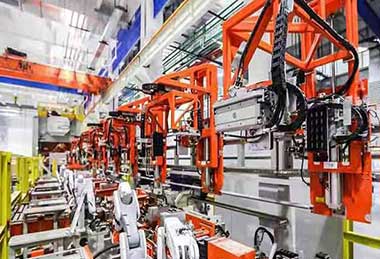
Overview of Manufacturing:Warehouses in the manufacturing sector often use cranes for tasks like loading and unloading raw materials, moving work-in-progress items, and positioning heavy machinery or equipment.
Typical Types of Warehouse Crane:
Overhead Bridge Cranes
- Gantry Cranes
- Jib Cranes
- Stacker Cranes (AS/RS)
- Pallet Jacks and Forklifts
Features of Warehouse Cranes:
High lifting capacity
- Efficient use of vertical space
- Wide coverage
- Ground mobility (for gantry cranes)
- Compact design (for jib cranes)
- Automation capabilities (for stacker cranes)
- Forks for pallet handling (for forklifts)
Benefits:
Increased efficiency in material handling
- Reduced labor costs
- Enhanced safety through precise load control
- Space optimization
Functions of Crane in Manufacturing Warehouse:
Loading and unloading heavy materials
- Transporting materials within the facility
- Positioning machinery and equipment
- Storing and retrieving items in high-bay racking systems
Application:Manufacturing warehouses use a variety of cranes to streamline their operations, ensuring the efficient movement and handling of materials and equipment. Overhead bridge cranes, for example, are used for heavy lifting, while stacker cranes in automated storage systems provide high-density storage solutions. Jib cranes are often employed for precise positioning of work-in-progress items, contributing to the overall productivity of manufacturing processes. Forklifts and pallet jacks play a crucial role in loading and unloading materials and transporting them within the facility, supporting just-in-time production practices.
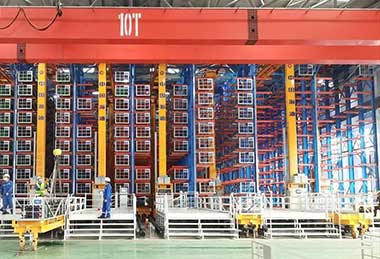
Logistics and Distribution Warehouse
Overview of Logistics and Distribution:Distribution centers and logistics companies use cranes to efficiently handle the receipt, storage, and shipment of goods. Overhead cranes and automated storage systems are common in this sector.
Typical Types of Warehouse Crane:
Overhead Bridge Cranes
- Stacker Cranes (AS/RS)
Features of Warehouse Cranes:
High lifting capacity
- Efficient storage and retrieval of goods
- Automated operation for rapid handling
- Space optimization
Benefits:
Faster order processing
- Reduced labor costs
- Improved inventory management
- Enhanced warehouse space utilization
Functions of Crane in Logistics and Distribution Warehouse:
Efficient loading and unloading of goods
- High-speed order picking and sorting
- Automated storage and retrieval
- Precise placement of items within the warehouse
Application:Logistics and distribution warehouses rely on cranes to optimize the movement and storage of goods, enabling timely and accurate order fulfillment. Overhead cranes efficiently load and unload shipments, while stacker cranes provide high-density storage solutions, ensuring products are readily available for distribution.
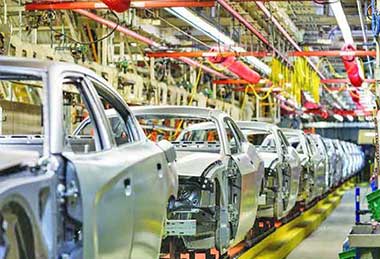
Overview of Automotive:Car manufacturing plants utilize overhead cranes to lift and position heavy vehicle components, such as engines and chassis, during assembly. Cranes are also used in automotive parts distribution warehouses.
Typical Types of Warehouse Crane:
Overhead Bridge Cranes
- Gantry Cranes
Features of Warehouse Cranes:
High lifting capacity
- Precise load control
- Efficient production line support
- Mobility (for gantry cranes)
Benefits:
Accelerated assembly processes
- Improved workplace safety
- Reduction in manual handling
- Enhanced vehicle production efficiency
Functions of Crane in Automotive Warehouse:
Positioning heavy vehicle components
- Safely transporting parts within the facility
- Loading/unloading materials for assembly
- Facilitating seamless logistics in parts distribution
Application:Automotive warehouses heavily rely on cranes to streamline production processes and ensure the timely delivery of vehicle components. Overhead cranes precisely position heavy parts during assembly, while gantry cranes efficiently move materials and components within the facility.
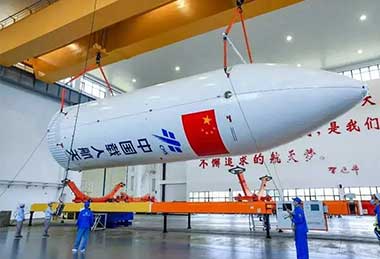
Aerospace Warehouse
Overview of Aerospace:In the aerospace industry, cranes are essential for moving large and delicate aircraft components, such as wings, fuselages, and engines, within production facilities.
Typical Types of Warehouse Crane:
Overhead Bridge Cranes
- Gantry Cranes
Features of Warehouse Cranes:
High lifting capacity
- Precise load control
- Safety measures for delicate components
- Mobility (for gantry cranes)
Benefits:
Facilitates assembly of large aircraft
- Ensures precise positioning of sensitive parts
- Increases production efficiency
- Enhances workplace safety
Functions of Crane in Aerospace Warehouse:
Handling and transportation of oversized components
- Accurate placement of aircraft parts
- Support for assembly and testing procedures
- Safe movement of engines and wings
Application:Aerospace warehouses rely on cranes to manage the intricate assembly of aircraft components. Overhead and gantry cranes are instrumental in positioning and transporting delicate parts during the manufacturing process.
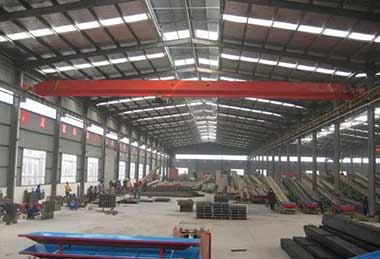
Construction Material Warehouse
Overview of Construction:Construction material warehouses employ gantry cranes and forklifts to manage and transport construction materials like steel beams, concrete panels, and precast components.
Typical Types of Warehouse Crane:
Gantry Cranes
- Forklifts
Features of Warehouse Cranes:
High load capacity
- Mobility and adaptability
- Efficient material handling
- Space-saving design
Benefits:
Streamlined construction material logistics
- Reduction in manual labor
- Improved workplace safety
- Accelerated construction project timelines
Functions of Crane in Construction Warehouse:
Transportation of heavy building materials
- Loading and unloading construction supplies
- Precise positioning of materials at the construction site
- Support for just-in-time material delivery
Application:Construction warehouses play a pivotal role in the construction industry by providing the necessary materials. Gantry cranes and forklifts efficiently handle and transport steel beams, concrete panels, and other construction materials, ensuring that construction projects progress smoothly.
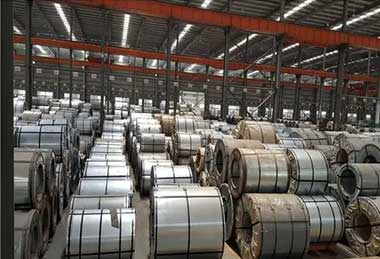
Steel and Metal Fabrication Warehouse
Overview of Steel and Metal Fabrication:Steel mills, foundries, and metal fabrication shops often use overhead cranes to handle and transport heavy metal sheets, coils, and structural components.
Typical Types of Warehouse Crane:
Overhead Bridge Cranes
Features of Warehouse Cranes:
High lifting capacity
- Efficient material handling
- Precision control
- Durability for heavy loads
Benefits:
Accelerated metal processing
- Improved safety during material handling
- Enhanced workplace efficiency
- Reduced material damage
Functions of Crane in Steel and Metal Fabrication Warehouse:
Loading/unloading metal sheets and coils
- Precise placement of materials for processing
- Transporting heavy metal components within the facility
- Supporting metal fabrication processes
Application:Steel and metal fabrication warehouses are essential for processing metal materials. Overhead cranes are instrumental in efficiently handling and transporting heavy metal sheets, coils, and structural components, facilitating the fabrication process.

Mining and Extraction Warehouse
Overview of Mining and Extraction:Mines and extraction facilities utilize cranes to hoist and transport ore, minerals, and heavy equipment in both underground and open-pit mining operations.
Typical Types of Warehouse Crane:
Gantry Cranes
- Overhead Bridge Cranes
Features of Warehouse Cranes:
High lifting capacity
- Durability for rugged environments
- Precision load control
- Safety features for underground use
Benefits:
Accelerated ore and mineral extraction
- Enhanced safety in challenging mining environments
- Efficient equipment maintenance
- Increased production capacity
Functions of Crane in Mining and Extraction Warehouse:
Hoisting and transporting ore and minerals
- Handling heavy mining equipment
- Supporting maintenance and repair of mining machinery
- Safely operating in underground mining tunnels
Application:Mining and extraction warehouses play a critical role in the resource extraction industry. Gantry cranes and overhead bridge cranes are essential for hoisting ore, minerals, and heavy equipment, ensuring efficient mining operations.
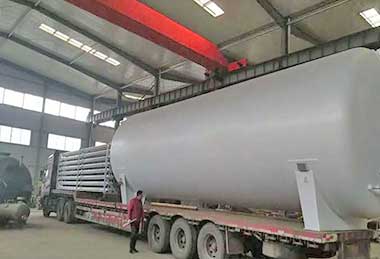
Overview of Oil and Gas:Warehouses in the oil and gas sector employ cranes for lifting and moving drilling equipment, pipes, valves, and other materials used in exploration, drilling, and production.
Typical Types of Warehouse Crane:
Overhead Bridge Cranes
- Gantry Cranes
Features of Warehouse Cranes:
High load capacity
- Durability for harsh environments
- Precision control
- Mobility (for gantry cranes)
Benefits:
Efficient handling of drilling equipment and materials
- Enhanced safety during material movement
- Increased oil and gas production efficiency
- Reduced manual labor in challenging environments
Functions of Crane in Oil and Gas Warehouse:
Lifting and transporting drilling equipment
- Moving pipes, valves, and materials for exploration and production
- Supporting maintenance of oil and gas infrastructure
- Safely operating in oilfield environments
Application:Oil and gas warehouses are crucial for the energy sector, ensuring the efficient handling of equipment and materials for exploration, drilling, and production. Overhead and gantry cranes play a pivotal role in moving heavy components in challenging oilfield environments.
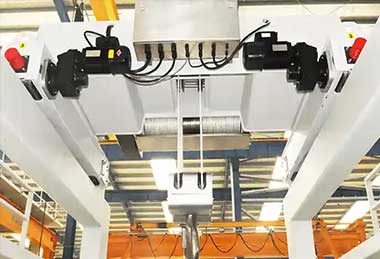
Overview of Food and Beverage:Cold storage warehouses for perishable goods employ specialized cranes designed to work in low-temperature environments to handle pallets and food products.
Typical Types of Warehouse Crane:
Cold Storage Cranes
Features of Warehouse Cranes:
Insulated components
- Corrosion-resistant materials
- Temperature control systems
- Efficient pallet handling
Benefits:
Maintains temperature integrity for perishable goods
- Efficient storage and retrieval of frozen or refrigerated products
- Improved food safety and quality control
- Streamlined handling of food products
Functions of Crane in Food and Beverage Warehouse:
Loading and unloading of temperature-sensitive products
- Efficient pallet handling in cold storage environments
- Facilitating precise storage and retrieval of food items
Ensuring compliance with food safety regulations
Application:Food and beverage warehouses are essential for the storage of perishable goods. Cold storage cranes play a vital role in maintaining temperature integrity, ensuring efficient storage, and precise handling of food products in refrigerated environments.

Pharmaceuticals and Healthcare Warehouse
Overview of Pharmaceuticals and Healthcare:Pharmaceutical manufacturers use cranes in cleanroom environments to safely move sensitive equipment and materials during the production of pharmaceuticals and medical devices.
Typical Types of Warehouse Crane:
Cleanroom Crane Systems
Features of Warehouse Cranes:
Cleanroom-compatible design
- Stainless steel or non-corrosive materials
- Precise load control
- Compliance with strict cleanliness standards
Benefits:
Ensures contamination-free material handling
- Facilitates adherence to pharmaceutical quality standards
- Increases production efficiency in cleanroom environments
- Minimizes the risk of product contamination
Functions of Crane in Pharmaceuticals and Healthcare Warehouse:
Safe and precise handling of pharmaceutical ingredients and equipment
- Supporting cleanroom operations without contamination
- Enhancing workflow efficiency in pharmaceutical production
- Maintaining compliance with healthcare industry regulations
Application:Pharmaceuticals and healthcare warehouses operate in strict cleanroom environments. Cleanroom crane systems are vital for the contamination-free handling of sensitive pharmaceutical ingredients and equipment, ensuring the production of safe and high-quality medical products.
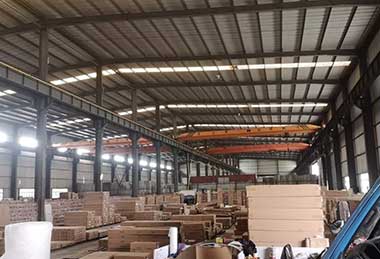
Retail and E-commerce Warehouse
Overview of Retail and E-commerce:E-commerce distribution centers rely on overhead cranes and AS/RS systems to efficiently process and ship customer orders in high-volume e-commerce operations.
Typical Types of Warehouse Crane:
Overhead Bridge Cranes
- Stacker Cranes (AS/RS)
Features of Warehouse Cranes:
High-speed order picking and sorting
- Space-efficient storage solutions
- Automation for rapid order fulfillment
- Precise load control
Benefits:
Faster order processing and shipment
- Reduced labor costs
- Enhanced inventory management
- Efficient space utilization in high-volume operations
Functions of Crane in Retail and E-commerce Warehouse:
High-speed order picking and sorting
- Automated storage and retrieval of goods
- Efficient loading and unloading of products
- Precise placement of items for order fulfillment
Application:Retail and e-commerce warehouses are at the forefront of high-volume order processing. Overhead cranes and stacker cranes play a pivotal role in efficiently handling and fulfilling customer orders, ensuring timely delivery and customer satisfaction.
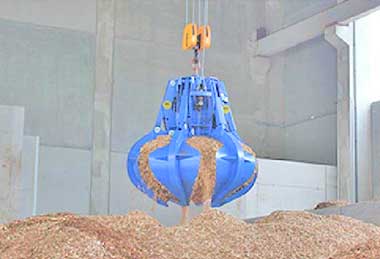
Energy and Utilities Warehouse
Overview of Energy and Utilities:Power plants, including nuclear, coal, and renewable energy facilities, use cranes for maintenance and the handling of heavy equipment and fuel.
Typical Types of Warehouse Crane:
Overhead Bridge Cranes
- Gantry Cranes
Features of Warehouse Cranes:
High lifting capacity
- Durability for industrial environments
- Precision load control
- Mobility (for gantry cranes)
Benefits:
Efficient maintenance and servicing of power generation equipment
- Increased safety in handling heavy machinery and fuel
- Enhanced power plant operational efficiency
- Reduced manual labor in challenging environments
Functions of Crane in Energy and Utilities Warehouse:
Hoisting and transporting heavy equipment
- Loading and unloading fuel and materials
- Supporting maintenance and repair of power generation infrastructure
- Safely operating in power plant environments
Application:Energy and utilities warehouses are vital for maintaining power generation facilities. Overhead and gantry cranes efficiently handle heavy equipment, fuel, and materials, ensuring the reliable operation of power plants.
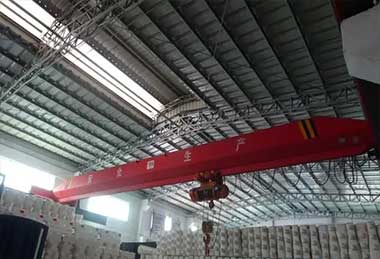
Chemical and Petrochemical Warehouse
Overview of Chemical and Petrochemical:Warehouses storing chemicals and petrochemical products require cranes to handle containers, drums, and bulk materials.
Typical Types of Warehouse Crane:
Overhead Bridge Cranes
- Gantry Cranes
Features of Warehouse Cranes:
Chemical-resistant materials
- High load capacity
- Precision control for handling hazardous materials
- Durability for corrosive environments
Benefits:
Safe handling of chemicals and petrochemicals
- Increased operational efficiency in material handling
- Enhanced workplace safety in hazardous environments
- Reduced risk of material spillage and accidents
Functions of Crane in Chemical and Petrochemical Warehouse:
Lifting and transporting chemical containers and drums
- Precise placement of hazardous materials
- Efficient loading and unloading of bulk chemicals
- Supporting maintenance of chemical storage facilities
Application:Chemical and petrochemical warehouses deal with hazardous materials. Overhead and gantry cranes are essential for the safe and efficient handling of chemical containers, drums, and bulk materials, minimizing the risk of accidents and environmental incidents.
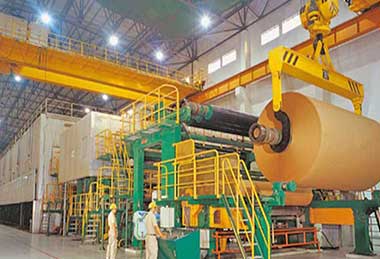
Overview of Paper and Pulp:Facilities involved in paper and pulp production use cranes to transport raw materials, finished products, and large rolls of paper within the production process.
Typical Types of Warehouse Crane:
Overhead Bridge Cranes
- Gantry Cranes
Features of Warehouse Cranes:
High load capacity
- Precision control for delicate paper rolls
- Efficient material handling
- Durability for industrial use
Benefits:
Efficient transport of paper rolls and raw materials
- Increased production efficiency in the paper and pulp industry
- Improved workplace safety during material handling
- Reduction in manual labor
Functions of Crane in Paper and Pulp Warehouse:
Transporting large rolls of paper
- Handling raw materials like wood pulp
- Facilitating efficient material flow in paper production
- Supporting maintenance and repair of papermaking equipment
Application:Paper and pulp warehouses play a pivotal role in the paper production industry. Overhead and gantry cranes are essential for the safe and efficient transport of large paper rolls and raw materials within the facility, contributing to the smooth operation of papermaking processes.
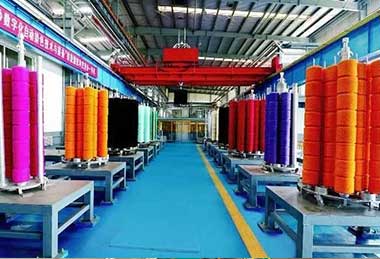
Overview of Textiles:Textile mills and warehouses use cranes to handle rolls of fabric, textile machinery
, and other materials involved in textile production.
Typical Types of Warehouse Crane:
Overhead Bridge Cranes
- Gantry Cranes
Features of Warehouse Cranes:
High load capacity
- Precision control for delicate textile materials
- Efficient material handling
- Durability for industrial use
Benefits:
Efficient handling and transport of textile rolls and materials
- Increased production efficiency in textile manufacturing
- Improved workplace safety during material handling
- Reduction in manual labor
Functions of Crane in Textiles Warehouse:
Transporting rolls of fabric and textile materials
- Handling textile machinery and equipment
- Facilitating efficient material flow in textile production
- Supporting maintenance and repair of textile machinery
Application:Textiles warehouses are central to the textile manufacturing industry. Overhead and gantry cranes are essential for the safe and efficient handling of textile rolls, machinery, and materials within the facility, ensuring the smooth operation of textile production processes.
As we explore these diverse industrial applications of warehouse cranes, it becomes clear that these versatile machines are indispensable in a wide range of sectors. They are the workhorses that drive efficiency, enhance safety, and enable the seamless flow of materials in countless industries. Stay with us as we continue to unveil the unique features, benefits, and applications of various types of warehouse cranes.
Warehouse Crane Costs and Pricing
The investment in warehouse cranes is a pivotal decision for any business, and understanding the costs and pricing is crucial. Let's delve into the factors that influence warehouse crane costs, explore the typical price ranges for different types of warehouse cranes, and highlight key considerations when making a crane investment.
Factors Affecting Warehouse Crane Costs
Warehouse crane costs can vary significantly based on several key factors:
- 1. Crane Type:Different types of warehouse cranes come with varying price tags. For example, overhead bridge cranes tend to be costlier than jib cranes due to their higher load capacity and more extensive features.
- 2. Load Capacity:The crane's load capacity directly impacts its cost. Cranes designed to handle heavier loads will generally be more expensive.
- 3. Span and Coverage:The span or coverage area that a crane needs to traverse affects its cost. Cranes with larger coverage areas, such as gantry cranes, may be pricier.
- 4. Customization:Custom features and specifications, such as specialized hooks, controls, or safety systems, can increase the crane's cost.
- 5. Installation Requirements:Installation costs, including structural modifications, electrical work, and permits, can significantly impact the overall cost of implementing a warehouse crane system.
- 6. Maintenance and Operating Costs:Consider the long-term costs associated with crane maintenance and operation, including power consumption and maintenance contracts.
- 7. Brand and Quality:Well-established brands and high-quality equipment often come at a premium price due to their reliability and durability.
- 8. Local Regulations:Compliance with local safety and building regulations may require additional investments in safety features and structural modifications.
Typical Price Ranges for Different Types of Warehouse Cranes
While prices can vary, here are typical price ranges for various types of warehouse cranes as of my last knowledge update in September 2021. Keep in mind that these ranges are approximate and can change over time due to market fluctuations:
- - Overhead Bridge Cranes:$1,000 to $200,000 or more, depending on capacity and features.
- - Gantry Cranes:$5,000 to $150,000 or more, with larger, more specialized models on the higher end.
- - Jib Cranes:$2,000 to $20,000, depending on capacity and reach.
- - Stacker Cranes (AS/RS):$5,000 to $500,000 or more, depending on automation levels and storage capacity.
- - Pallet Jacks and Forklifts:$2,000 to $50,000, based on capacity and features.
- - Cold Storage Cranes:$2,000 to $100,000 or more, depending on low-temperature compatibility and features.
- - Cleanroom Crane Systems:$2,000 to $150,000 or more, with a focus on compliance with cleanroom standards.
Considerations for Crane Investment
Investing in warehouse cranes is a significant decision that should be made after careful consideration. Here are some key factors to keep in mind:
- 1. Specific Needs:Assess your material handling requirements, including load capacity, reach, and frequency of use. Choose a crane type that aligns with your needs.
- 2. Budget:Establish a clear budget for your crane investment, considering not only the initial purchase cost but also installation, maintenance, and operational expenses.
- 3. Quality and Reliability:Prioritize quality and reliability over the lowest price. Well-built cranes tend to offer better long-term value.
- 4. Safety:Ensure that the chosen crane complies with safety standards and regulations. Invest in safety features to protect both your workforce and equipment.
- 5. Space and Infrastructure:Evaluate your warehouse's layout and structural capacity to accommodate the crane system. Factor in any required modifications.
- 6. Future Expansion:Consider your business's growth potential. Choose a crane system that can be adapted or expanded as your needs evolve.
- 7. Vendor Reputation:Research crane manufacturers and suppliers, checking for their reputation, customer reviews, and after-sales support.
- 8. Maintenance and Training:Plan for regular maintenance and operator training to ensure safe and efficient crane operation.
By carefully assessing your needs, budget, and long-term goals, you can make an informed decision regarding the type of warehouse crane to invest in and manage your crane costs effectively. Warehouse cranes are not just equipment; they are an investment in the efficiency and productivity of your operations.
Top Concerns of Warehouse Crane Users
Warehouse crane users have several important concerns that impact their operations and overall success. Addressing these concerns is essential to ensure the safe, efficient, and productive use of crane systems. Let's explore the top concerns of warehouse crane users:
Safety Measures and Regulations
- Safety is paramountwhen operating warehouse cranes. Users are concerned about:
- - Accident Prevention:Implementing safety measures to prevent accidents, including collision avoidance systems, load limiters, and warning devices.
- - Compliance:Adhering to local and international safety regulations, such as OSHA (Occupational Safety and Health Administration) standards.
- - Operator Training:Providing thorough training and certification for crane operators to ensure safe and responsible handling of loads.
- - Maintenance:Regular maintenance and inspections to identify and address potential safety issues.
Maintenance and Service Requirements
Users are concerned about the ongoing maintenance and service needs of warehouse cranes:
- - Downtime:Minimizing downtime due to maintenance and repairs to maintain operational efficiency.
- - Scheduled Maintenance:Planning and executing routine maintenance tasks, such as lubrication, component inspections, and preventive repairs.
- - Emergency Repairs:Addressing unexpected breakdowns promptly to reduce disruptions to operations.
- - Parts Availability:Ensuring the availability of replacement parts to expedite repairs.
Crane Operator Training and Certification
Properly trained and certified crane operators are essential for safe and efficient operations:
- - Training Programs:Providing comprehensive training programs that cover crane operation, load handling, safety procedures, and emergency response.
- - Certification:Ensuring that crane operators obtain the necessary certifications to operate specific crane types.
- - Continuous Learning:Offering ongoing training and skill development opportunities for operators to stay updated with best practices and new technologies.
Integration with Warehouse Management Systems (WMS)
Integrating crane systems with warehouse management systems (WMS) is crucial for optimizing material handling processes:
- - Compatibility:Ensuring that crane systems can seamlessly integrate with existing or planned WMS software.
- - Data Exchange:Enabling real-time data exchange between the crane system and WMS for inventory tracking, order management, and automated decision-making.
- - Efficiency Gains:Leveraging WMS integration to improve inventory accuracy, order fulfillment speed, and overall warehouse efficiency.
Energy Efficiency and Environmental Considerations
Users are increasingly concerned about environmental impact and energy efficiency:
- - Energy Consumption:Reducing the energy consumption of crane systems through energy-efficient components and technologies.
- - Sustainability:Implementing sustainable practices in crane operations, such as using eco-friendly lubricants and materials.
- - Emissions Reduction:Minimizing emissions from crane systems through the use of electric or hybrid power sources.
- - Environmental Compliance:Ensuring compliance with environmental regulations related to crane operations.
Addressing these concerns requires a holistic approach that considers safety, maintenance, training, technology integration, and environmental impact. Warehouse crane users are continually seeking ways to enhance their operations while prioritizing the well-being of their workforce and the environment. Manufacturers and suppliers play a vital role in addressing these concerns by offering innovative solutions and comprehensive support services.
Frequently Asked Questions (FAQs)
In this section, we provide answers to common queries related to warehouse cranes. Whether you're a crane user, potential purchaser, or simply curious about these essential material handling tools, you'll find expert answers to key questions.
Common Queries Related to Warehouse Cranes
1. What is the purpose of a warehouse crane?
- A warehouse crane is designed to efficiently move, lift, and handle materials and goods within warehouses and industrial facilities. Its primary purpose is to streamline material handling processes, increase productivity, and enhance safety.
2. What are the main types of warehouse cranes?
- The main types of warehouse cranes include overhead bridge cranes, gantry cranes, jib cranes, stacker cranes (AS/RS), pallet jacks, forklifts, cold storage cranes, and cleanroom crane systems. Each type has specific features and applications.
3. What factors should I consider when choosing a warehouse crane?
- When selecting a warehouse crane, consider factors such as load capacity, reach or coverage area, customization options, installation requirements, maintenance needs, and compliance with safety regulations.
4. How can I ensure the safety of warehouse crane operations?
- Safety measures for warehouse crane operations include operator training and certification, regular maintenance, compliance with safety regulations, the use of safety devices (e.g., limit switches and load limiters), and collision avoidance systems.
5. What are the typical applications of warehouse cranes in various industries?
- Warehouse cranes find applications in diverse industries, including manufacturing, logistics, automotive, aerospace, construction, steel fabrication, mining, oil and gas, food and beverage, pharmaceuticals, retail, energy, chemicals, paper and pulp, and textiles.
6. What are the costs associated with warehouse cranes?
- Warehouse crane costs vary based on factors like crane type, load capacity, span, customization, installation requirements, and maintenance. Typical price ranges for different types of cranes were covered earlier in this blog.
7. How can I integrate a warehouse crane with my warehouse management system (WMS)?
- Integration with a WMS involves selecting a crane system compatible with your software, enabling real-time data exchange through APIs or middleware, and configuring the WMS to communicate with the crane for tasks such as order picking and inventory management.
8. What are some environmentally friendly features of warehouse cranes?
- Environmentally friendly warehouse crane features include energy-efficient components, electric or hybrid power sources to reduce emissions, sustainable materials, and compliance with environmental regulations.
Expert Answers to Key Questions
9. What are the benefits of using an overhead bridge crane in manufacturing warehouses?
- Overhead bridge cranes offer high load capacity, precise control, and durability. They benefit manufacturing warehouses by efficiently handling raw materials, work-in-progress items, and heavy machinery, thereby increasing productivity.
10. How do gantry cranes enhance efficiency in steel and metal fabrication facilities?
- Gantry cranes are instrumental in steel and metal fabrication due to their high load capacity and mobility. They facilitate the handling and transport of heavy metal sheets, coils, and structural components, leading to improved workflow efficiency.
11. What safety measures should be taken when operating a jib crane in construction settings?
- Safety measures for jib crane operations in construction include regular inspections, load capacity adherence, proper rigging techniques, operator training, and clear communication between crane operators and ground personnel.
12. Why are cleanroom crane systems essential in pharmaceutical and healthcare warehouses?
- Cleanroom crane systems are vital in pharmaceutical and healthcare settings to prevent contamination. They are designed with materials and features that meet strict cleanliness standards, ensuring the safe and sterile handling of sensitive pharmaceutical equipment and materials.
13. How do stacker cranes (AS/RS) optimize storage in retail and e-commerce warehouses?
- Stacker cranes, often integrated into automated storage and retrieval systems (AS/RS), enhance storage optimization by efficiently stacking and retrieving goods in high-density storage racks. This results in faster order processing and space savings in retail and e-commerce warehouses.
14. What are the considerations for reducing energy consumption in energy and utility warehouses with overhead cranes?
- To reduce energy consumption, consider using energy-efficient motors and controls, optimizing crane speed settings, and implementing regenerative braking systems. Additionally, ensure that crane maintenance is performed regularly to keep components operating efficiently.
15. How can chemical and petrochemical warehouses minimize the environmental impact of crane operations?
- Chemical and petrochemical warehouses can reduce their environmental impact by choosing cranes with eco-friendly features, such as energy-efficient components and emissions-reducing technologies. Proper waste disposal and compliance with environmental regulations are also crucial.
These FAQs provide valuable insights into the world of warehouse cranes, offering guidance on their selection, operation, safety, and environmental considerations. If you have further questions or need more information, don't hesitate to consult with crane manufacturers and experts who can tailor solutions to your specific needs and challenges.
Conclusion
In conclusion, warehouse cranes are indispensable tools in the world of material handling, playing a pivotal role in various industries and applications. As we wrap up this comprehensive guide, let's summarize the key warehouse crane types and their benefits and offer some final thoughts on choosing the right warehouse crane for your specific needs.
Summary of Warehouse Crane Types and Benefits
We explored a diverse range of warehouse crane types, each tailored to specific material handling tasks. Here's a brief recap of the crane types and their benefits:
- 1. Overhead Bridge Cranes:These versatile cranes are known for their high load capacity, precision control, and adaptability in manufacturing, construction, and more.
- 2. Gantry Cranes:Gantry cranes combine mobility with heavy lifting capabilities, making them ideal for steel fabrication, shipyards, and other settings.
- 3. Jib Cranes:Jib cranes are space-saving solutions, commonly used in construction, manufacturing, and automotive applications for their efficiency and flexibility.
- 4. Stacker Cranes (AS/RS):Stacker cranes, often integrated into AS/RS systems, optimize storage and retrieval processes, enhancing efficiency in retail and e-commerce warehouses.
- 5. Pallet Jacks and Forklifts:These essential tools excel in material transport and are commonly used in logistics, distribution, and manufacturing.
- 6. Cold Storage Cranes:Designed to withstand low-temperature environments, cold storage cranes are crucial for handling perishable goods in the food and beverage industry.
- 7. Cleanroom Crane Systems:These specialized cranes meet strict cleanliness standards, making them essential in pharmaceutical and healthcare settings.
Final Thoughts on Choosing the Right Warehouse Crane
Selecting the right warehouse crane involves careful consideration of your unique requirements and operational context. Here are some final thoughts to guide your decision:
- - Needs Assessment:Begin by thoroughly assessing your material handling needs, including load capacity, reach, and frequency of use.
- - Budget Planning:Establish a clear budget that encompasses initial purchase costs, installation, maintenance, and operational expenses.
- - Quality and Reliability:Prioritize quality and reliability over the lowest price, as well-built cranes offer better long-term value.
- - Safety First:Ensure compliance with safety regulations, prioritize operator training, and implement safety features to protect your workforce and equipment.
- - Environmental Considerations:If sustainability is a concern, explore eco-friendly crane options and practices to minimize your environmental footprint.
- - Vendor Selection:Research crane manufacturers and suppliers, considering their reputation, customer reviews, and after-sales support.
Warehouse cranes are not merely equipment; they are investments in the efficiency, productivity, and safety of your operations. By making informed decisions and selecting the right crane for your specific needs, you can enhance your material handling processes and contribute to the success of your business.
Thank you for joining us on this journey through the world of warehouse cranes. If you have further questions or require assistance in selecting the ideal crane for your application, don't hesitate to reach out to crane experts and manufacturers who can provide tailored solutions to meet your goals.
Related Products

Latest project
150 Ton Overhead Crane Installation Feedback – Paraguay Case
QDX 150 ton overhead crane in action in Paraguay. Installation photos, video, and client feedback show performance, safety, and heavy-lifting efficiency.
Free consultation to Confirm Parameters & Specifications and Get
Latest Crane Price & Crane Rate.
- Types of overhead cranes : _______?
- Optional: Overhead travelling crane, goliath gantry crane,Slewing jib crane, Single girder or double girder crane,small portable crane or kbk crane, etc.
- Capacity of overhead crane: _______?
- Optional: 0.25ton, 0.5 ton, 1 ton, 2 ton, 3ton, 5 ton, 10 ton,15ton, 20ton, 25 ton, 30ton,35ton, up to 550ton, etc.
- Crane span & lifting height : _______?
- Crane travelling length : _____?
- Control of overhead crane:_______?
- Optional: pendant/ remote/cabin control
- Voltage supply of overhead crane:_____?
- Eg,: 380V50/60HZ,3Phase or others,etc.
- Application/usage of crane:_______?
- Eg,: Steel mill, ,injection mold, cement,stone, concrete,granite, general manufacturing, etc.
Just leave a message via the contact form and our hoist and crane engineer will contact you with in 24working hours.
Get In Touch
